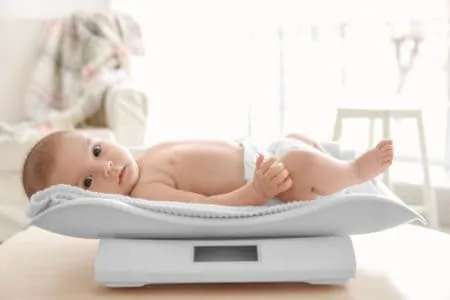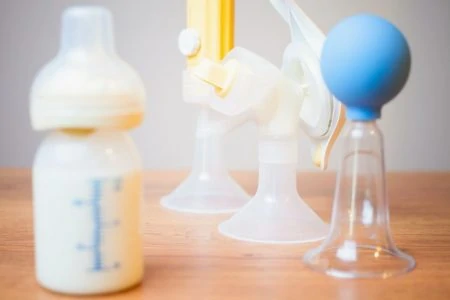Do you find yourself struggling to breastfeed because of flat or inverted nipples? You’re not alone.
An estimated 10% of women experience one of the two and have questions about how it may affect their ability to nurse.
We understand how moms feel when they battle with their body to provide nourishment for their child. Luckily, with a little bit of knowledge and practice, you can learn how to breastfeed with flat or inverted nipples. Contrary to what you may have heard, no nipple shape prevents you from breastfeeding as long as you’re prepared.
In this article, we’ll cover what flat and inverted nipples are, how to tell if you have them, and tips on how to improve your breastfeeding experience if you do.
Key Takeaways
- Flat and inverted nipples can make breastfeeding more challenging, but it is still possible with preparation and practice.
- The pinch test can help determine if you have flat or inverted nipples.
- Techniques like nipple stimulation, the deep latch technique, and the Hoffman Technique can assist with breastfeeding.
- Breast shells, nipple shields, and suction pumps are helpful tools for moms with flat or inverted nipples during breastfeeding.
The Anatomy of Your Breast
Understanding the anatomy of your breasts is the first step to successful breastfeeding.
Internally, your breast is composed of milk glands, milk ducts, fatty tissue, and muscles. Milk is produced and available to your baby through external anatomy (1).
Externally, you have the areola and the nipple. The areola, comprised of darker skin, surrounds the nipple from which milk is released. After giving birth, you’ll experience many natural changes to automatically produce and secrete milk for nursing.
The size, shape, and coloring of your nipples and areola vary based on a variety of factors, including the color of your skin, the size of your breasts, and your genetics. For most women, the nipple protrudes out from the areola.
However, some experience flat or inverted nipples that may become a cause of concern.
Flat & Inverted Nipples
A flat nipple occurs when the nipple does not become erect and apart from the areola, causing your areola and nipple to seem like one flat surface. An inverted nipple, instead of protruding out, protrudes in. Most women are born with flat or inverted nipples, and neither is an indicator of a serious health issue (2).
However, if you were born with a protruding or erect nipple and suddenly notice a change, you’ll want to mention it to your doctor. Sometimes, a change in your nipple shape can indicate a potential problem (3).
The Pinch Test
Every mom’s body is different, and it’s not always easy to know if your nipples protrude normally. Some nipples may seem flat but can actually be coaxed to an erect position. Breasts engorged with milk can also seem flatter than normal.
To see if you have truly flat or inverted nipples, try the pinch test. Take your thumb and index finger and place them around the areola and breast, approximately one inch away from the edge. Gently squeeze.
A normal nipple will protrude, while a flat nipple will remain flat. If your nipple is inverted, the pinch test should pull it inward (4).
How Flat Nipples Impact Breastfeeding
To breastfeed, your baby must latch onto your breast. A good latch means the areola is mostly inside your baby’s mouth, and their lips turn outward in a fish-like position. Without a protruding nipple, this process may become more complicated, especially if your baby already has difficulty latching or a weak suck.
However, no nipple shape prevents you from breastfeeding completely. And nipple shape doesn’t affect your milk production either. As long as you prepare, you and your baby can both have a positive breastfeeding experience.
Tips for Breastfeeding with Flat Nipples
To start, let’s take a closer look at some simple, basic steps you can take to encourage your baby to nurse if you have flat or inverted nipples. For many moms, the solution may be simpler than you think.
1. Breastfeed Early
Babies have an instinct to nurse. After all, they need nourishment, and their little bodies are equipped to get it.
By breastfeeding as soon as you can after birth, you’ll help your baby grow accustomed to nursing from your body. Your breasts will also be softer before your milk fully comes in, which will make it easier to latch if you have flat or inverted nipples.
If possible, try not to introduce any form of nipple other than your own, including pacifiers.
2. Nipple Stimulation
You may be able to draw out a flatter nipple manually with a bit of stimulation. Simply rubbing or tugging gently on the nipple can help right before breastfeeding. Some moms also use cold water or ice.
However, it’s important you don’t work your breast too hard. Many moms experience sensitivity in the breast, and you don’t want to cause or contribute to any irritation. Always be gentle and avoid motions that cause pain.
3. The Deep Latch Technique
This breastfeeding technique will help your baby latch properly. It’s been known to help moms with flat or inverted nipples. Here’s how it’s done:
- Use the football or cross-cradle hold to compress your breast.
- With one hand, support your baby’s neck and head. Lift your baby’s head by using the heel of your hand to press between their shoulder blades gently.
- Rest your nipple just above your baby’s upper lip. Once your baby opens their mouth wide, help guide your breast into your baby’s lower jaw.
- You should now be able to lift your baby’s head forward so that the upper jaw completely covers the areola.
- Release your hand when your baby is latched on, and see if they begin to nurse.
4. The Hoffman Technique
The Hoffman Technique has been used since the 1950s to help moms draw out inverted nipples. It’s done by pressing your thumbs firmly into your breast right at the base of the nipple. Then, after pressing down, you pull out (5).
This action is done around the entire nipple at least once a day. While many women have used the Hoffman Technique and found success, no scientific studies have been done to test its effectiveness.
Helpful Breastfeeding Tools for Flat Nipples
Sometimes, moms with flat or inverted nipples need a little extra help after these basic methods fail. Multiple tools and aids have been created to resolve some of these issues and may be worth looking into.
1. Breast Shells
Breast shells were designed to help correct flat or inverted nipples. While the design varies by brand, the general functionality is the same.
Most breast shells are made of plastic or silicone and are comprised of two pieces for each breast. The inner piece encircles your nipple, placing pressure directly on the breast tissue. The outer piece connects to the inner piece and is normally designed to cover the nipple so that it doesn’t come in contact with your bra.
The pressure of a breast shell can help extract a flat or inverted nipple, making it more prominent and easier for your baby to latch onto. Breast shells are also used to help collect breast milk and prevent staining and leaks (6). This is great if your breasts are engorged or if your nipples are cracked and sore.
Here are two examples of breast shells:
2. Nipple Shields
Nipple shields are similar to breast shells but are meant to be used during breastfeeding. The shield covers a portion of your breast, areola, and nipple. A small opening in the tip of the nipple allows milk to flow through the shield so your baby can nurse.
If your nipple is flat or inverted, a nipple shield provides a protruding nipple for your baby to latch onto.
When looking for a nipple shield, find a product free of BPA and other dangerous chemicals that could leech into your breast milk as your baby nurses.
Here are two examples of recommended nipple shields:
3. Suction Pumps
A gentle, natural solution to flat or inverted nipples is a suction pump or cup. They use the power of suction to pull your nipple into a more erect position. They’re a great option for moms without extreme flatness or inversion.
You can also use a breast pump to achieve a similar effect.
Here are two suction pumps and cups you might like:
Medical Procedures for Flat Nipples
In some cases, more permanent measures can be taken to correct flat or inverted nipples. Before making any permanent modifications to your body, make sure to talk to your doctor about your options and what risks are associated with each procedure.
1. Nipple Piercings
One unique option is to pierce your nipples. The most effective piercing for an inverted nipple involves a bar that runs straight through the nipple. This bar may help to keep your nipple erect.
Nipple piercings shouldn’t affect your ability to breastfeed, though there are some risks involved.
First and foremost, you’ll want to be extra careful about your baby’s latch and avoid any jewelry that might become a choking hazard (7). Any foreign object going inside your baby’s mouth should be sanitized and made of safe materials.
You’ll also want to monitor how your breast feels after getting the piercing. Sometimes, your nerves and muscle reflexes can be affected, which may impact breastfeeding. If you have any tingling or numbing sensations, make sure to talk to your doctor.
2. Nipple Surgery
If your case is extreme, nipple surgery may be an option. Multiple procedures are available and range in cost and recovery time. Doctors can add fillers, use skin grafts to create more tissue, and do a full inverted nipple correction surgery.
Make sure to let your doctor know you want to preserve your milk ducts and plan to breastfeed should you discuss any form of nipple surgery. One of the most common procedures to fix inverted nipples removes the milk ducts and makes breastfeeding in the future impossible (8).
You’ll want to be clear about the risks and your goals before undergoing any procedure. Talk to a doctor about all your options.
Your Lactation Consultant
If you haven’t talked with a lactation consultant, find one in your area. Lactation consultants receive specific training and certification to help mothers breastfeed (9). They’ll answer your questions and create a specific treatment plan to help address the issues you’re facing.
You can find a lactation consultant by talking with your doctor about their recommendations or by using a site like this one to find certified consultants in your area.
FAQs
Some Hope for Breastfeeding
No matter what your nipple shape or type is, breastfeeding is a journey for every mom, and it isn’t always easy. Flat or inverted nipples may seem like a cause for concern, but the resources available can help put your mind at ease. If you’re feeling stressed or struggling, we recommend talking with a lactation consultant and learning more about your options.












